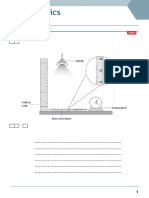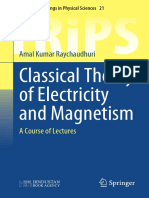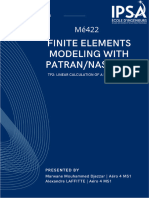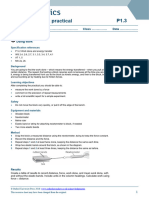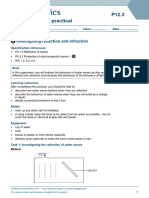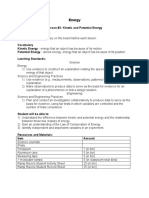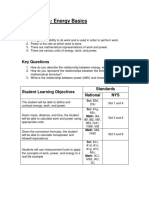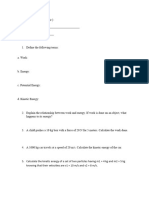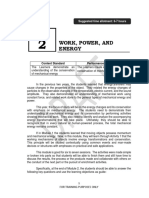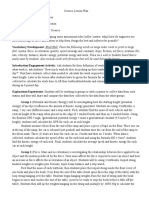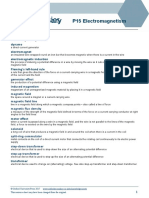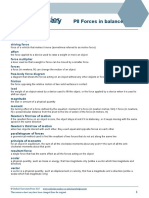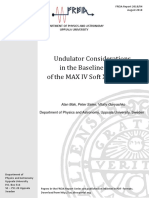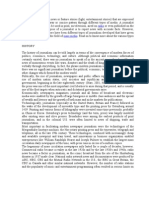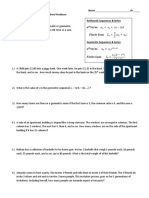P1.1 Student Working Scientifically: Energy Analogies
P1.1 Student Working Scientifically: Energy Analogies
Uploaded by
AlenCopyright:
Available Formats
P1.1 Student Working Scientifically: Energy Analogies
P1.1 Student Working Scientifically: Energy Analogies
Uploaded by
AlenOriginal Title
Copyright
Available Formats
Share this document
Did you find this document useful?
Is this content inappropriate?
Copyright:
Available Formats
P1.1 Student Working Scientifically: Energy Analogies
P1.1 Student Working Scientifically: Energy Analogies
Uploaded by
AlenCopyright:
Available Formats
P1.
1
Student working scientifically
Name....................................................................... Class................... Date......................
Energy analogies
Specification references:
P1.1.1 Energy stores and systems
P1.1.2 Changes in energy
P1.1.3 Energy changes in systems
WS1.1b, WS1.4a
Aims
You will be learning how to use analogies effectively to explain different physics
concepts.
Learning outcomes
After completing this worksheet, you should be able to:
use money as an analogy for energy, energy transfers, and power
describe how energy stores can be used to explain how energy is stored and transferred in different
systems.
Setting the scene
Energy is a very abstract concept which helps scientists to make calculations and
predict what changes can, or cannot, happen in a system.
Since energy is not a ‘thing’ that can be touched and seen, it is quite difficult to
find good analogies to describe what it is and describe how it is transferred
between different parts of a system.
Energy cannot be created or destroyed, it can only be transferred between parts
of a system, or between different systems. Energy can be stored and calculated,
so using the idea of ‘stores’ where energy can be ‘found’ and ‘collected’ can be a
useful tool.
Worked example
Energy concepts allow us to make useful calculations about a system. For
example, a climbing centre wants to know at what speed a climber would reach
the floor if they fell from a height of 6.5 m, so they can fit the floor with the right
amount of protective foam.
It is useful to consider the start and end points in this example. We can define the
start point as the 6.5 m height reached by the climber and our end point as the
floor of the gym, when the climber is about to hit the floor, but has not yet made
contact with it.
© Oxford University Press 2017 www.oxfordsecondary.co.uk/acknowledgements
This resource sheet may have been changed from the original. 1
P1.1
Student working scientifically
Name....................................................................... Class................... Date......................
The gravitational potential energy store of the climber will have filled to an amount
we can calculate using the equation Ep mgh (where g 10 m/s2).
When the climber has reached the floor, the gravitational potential store has
emptied and their kinetic energy store has filled by the same amount of energy
that was stored in our start point (this is if we ignore heating effects of air
resistance).
We can calculate the energy in the kinetic store with the equation Ek 0.5 mv 2
and, because Ep Ek in our example, then:
mgh 0.5 mv2
We can divide both sides by m to get:
gh gh 10 x 6. 5
gh 0.5v → v
2 2 0.5 → v √ 0.5 √ 0. 5 11.4 m/s
Task
A student pushes a sprung biro on the table vertically and then lets go. As a
result, the pen jumps vertically and reaches its highest point before falling down
again on the table.
Describe how energy is transferred when the pen has reached its highest point in
the jump using the idea of energy stores.
© Oxford University Press 2017 www.oxfordsecondary.co.uk/acknowledgements
This resource sheet may have been changed from the original. 2
P1.1
Student working scientifically
Name....................................................................... Class................... Date......................
Questions
1 Consider the sprung pen in the task and answer the questions.
a Use the equation elastic potential energy 0.5 spring constant (extension)2
to calculate the maximum height the pen can reach, if the spring constant
k 209 N/m, the spring of the pen is compressed by e 0.030 m, the mass of
the pen m 0.032 kg and g 10 m/s.
(5 marks)
b Explain using the idea of energy stores why the pen is unlikely to reach the
height calculated in question 1 a.
(3 marks)
© Oxford University Press 2017 www.oxfordsecondary.co.uk/acknowledgements
This resource sheet may have been changed from the original. 3
P1.1
Student working scientifically
Name....................................................................... Class................... Date......................
2 Some people find it useful to compare energy transfers with money. For
example, a girl who goes to a shop with a £10 note to buy a drink that costs £2
will expect to go back home with £8.
a Explain how this analogy is similar to a ball dropped by a height of 1 m that
bounces back up to a height of 0.8 m.
(3 marks)
b A child in yr7 receives £5 pocket money every week from her dad. Another
child receives £10 pocket money each week. Explain how this analogy
could be used to explain the concept of power.
(5 marks)
© Oxford University Press 2017 www.oxfordsecondary.co.uk/acknowledgements
This resource sheet may have been changed from the original. 4
You might also like
- 9e Ch10 Mini Case Test of DetailsDocument2 pages9e Ch10 Mini Case Test of DetailsEugene Cestina8% (12)
- Picture-Perfect STEM Lessons, Kindergarten: Using Children's Books for Three-Dimensional LearningFrom EverandPicture-Perfect STEM Lessons, Kindergarten: Using Children's Books for Three-Dimensional LearningNo ratings yet
- P1.2 Student Practical: Bungee JumpingDocument6 pagesP1.2 Student Practical: Bungee JumpingAlenNo ratings yet
- P1.2 Teacher Working Scientifically: Falling Cake CupsDocument3 pagesP1.2 Teacher Working Scientifically: Falling Cake CupsAlenNo ratings yet
- Model Lab Report (Parachutes) Y10,11 2017 AnnotatedDocument7 pagesModel Lab Report (Parachutes) Y10,11 2017 AnnotatedRita Lim100% (1)
- P1.2 Student Working Scientifically: Falling Cake CupsDocument4 pagesP1.2 Student Working Scientifically: Falling Cake CupsAlenNo ratings yet
- Oxo AQA16 P101 pr01 XxaannDocument6 pagesOxo AQA16 P101 pr01 XxaannAlenNo ratings yet
- Oxo AQA16 P101 pr01 XxaannDocument6 pagesOxo AQA16 P101 pr01 XxaannAlenNo ratings yet
- Case Study - Celeritas, Inc. Leadership Challenges in A Fast - Growth IndustryDocument3 pagesCase Study - Celeritas, Inc. Leadership Challenges in A Fast - Growth IndustryNarendra RamisettiNo ratings yet
- Oxo AQA16 P1uu T801 XxaannDocument8 pagesOxo AQA16 P1uu T801 Xxaann4cpzx7fp52No ratings yet
- P1.1 Teacher Working Scientifically: Energy AnalogiesDocument2 pagesP1.1 Teacher Working Scientifically: Energy AnalogiesAlenNo ratings yet
- Oxo AQA16 P1uu T401 XxaannDocument7 pagesOxo AQA16 P1uu T401 Xxaann2020-6582No ratings yet
- Oxo Act01 Pcuu rs00 XxaannDocument116 pagesOxo Act01 Pcuu rs00 XxaannAngkelova ChristinaNo ratings yet
- Science Coursework SampleDocument4 pagesScience Coursework Samplebcreq2m5100% (2)
- P1 Revision OverviewDocument3 pagesP1 Revision Overviewian McMillanNo ratings yet
- Lesson 16 - Energy, Motion & Pressure Revision TasksDocument13 pagesLesson 16 - Energy, Motion & Pressure Revision Tasksminal.thee.greatNo ratings yet
- P1 Exam questions ELADocument5 pagesP1 Exam questions ELAAyman No ratings yet
- Edexcel Pendulum CourseworkDocument6 pagesEdexcel Pendulum Courseworkafjwduenevzdaa100% (2)
- How To Do Science CourseworkDocument9 pagesHow To Do Science Courseworkvtdvkkjbf100% (2)
- Oxo AQA16 P805 ls01 XxaannDocument5 pagesOxo AQA16 P805 ls01 XxaannAdam ChiangNo ratings yet
- Basic Science CourseworkDocument6 pagesBasic Science Courseworkpodajokityk2100% (1)
- Oxo AQA16 P2uu T801 XxaannDocument9 pagesOxo AQA16 P2uu T801 XxaannSunaina BadhanNo ratings yet
- Chemistry Pre-Enrolment Task 2020-21Document11 pagesChemistry Pre-Enrolment Task 2020-21aleezaqureshi2007No ratings yet
- Energy Transfers Homework SheetDocument4 pagesEnergy Transfers Homework Sheetg3rzcx36100% (1)
- Two Bit Circus High School High School Physics Conservation of Energy Chain Reaction 4 Lesson Plans For Conservation of Energy Module 1Document7 pagesTwo Bit Circus High School High School Physics Conservation of Energy Chain Reaction 4 Lesson Plans For Conservation of Energy Module 1Adan CaacbayNo ratings yet
- Science Coursework ExampleDocument4 pagesScience Coursework Exampleafazamfbk100% (2)
- Transition From GCSE To A LevelDocument14 pagesTransition From GCSE To A LevelMasih KhanNo ratings yet
- DA SLG and Energy 1-9 Syllabus v2Document20 pagesDA SLG and Energy 1-9 Syllabus v2Bilal Shahid CheemaNo ratings yet
- PHYSICS Holiday Homework XIIDocument2 pagesPHYSICS Holiday Homework XIIaaravmohan208No ratings yet
- P1.2 Student Practical: Investigating PendulumsDocument6 pagesP1.2 Student Practical: Investigating PendulumsAlenNo ratings yet
- GenMath 11 - Q1 - Module 1 Represents Real-Life Situations Using FunctionsDocument17 pagesGenMath 11 - Q1 - Module 1 Represents Real-Life Situations Using FunctionsJennifer Domingo LorenzoNo ratings yet
- 2023 Light, Sound, and Electricity Practical ManualDocument42 pages2023 Light, Sound, and Electricity Practical ManualKatrina BerhaussenNo ratings yet
- Checkpoint Science Scheme of Work Physics - Year 1 Topic: Measurement AimsDocument9 pagesCheckpoint Science Scheme of Work Physics - Year 1 Topic: Measurement AimsvinuyeNo ratings yet
- Edexcel Physics A2 Coursework PendulumDocument6 pagesEdexcel Physics A2 Coursework Pendulumdrrzjaifg100% (2)
- SeismicWaves KerboodleDocument4 pagesSeismicWaves Kerboodlekavan.avnishNo ratings yet
- Classical Theory of Electricity and Magnetism: Amal Kumar RaychaudhuriDocument302 pagesClassical Theory of Electricity and Magnetism: Amal Kumar RaychaudhuriOtto ResnikovNo ratings yet
- Simple Pendulum CourseworkDocument7 pagesSimple Pendulum Courseworkbdg8266a100% (3)
- LAS-Kinetic Energy and Potential Energy - AmyDocument7 pagesLAS-Kinetic Energy and Potential Energy - AmyAmy Ajoste Nacin100% (1)
- TP2 Djezzar Laffitte MS1Document10 pagesTP2 Djezzar Laffitte MS1icelebgNo ratings yet
- Oxo Act02 p209 As01 XxaannDocument7 pagesOxo Act02 p209 As01 XxaannAditya SarmaNo ratings yet
- P1.3 Doing Work Practical SheetDocument4 pagesP1.3 Doing Work Practical Sheet21tahiradamNo ratings yet
- Euro International School: Summer HolidayhomeworkDocument32 pagesEuro International School: Summer HolidayhomeworkIshaan SharmaNo ratings yet
- P12.3 WSDocument4 pagesP12.3 WStholmesNo ratings yet
- Class X Holiday Homework-3Document7 pagesClass X Holiday Homework-3actllkitchencornerNo ratings yet
- Year 8 Energy ChecklistDocument2 pagesYear 8 Energy Checklistkevinwang650305No ratings yet
- P12.3 PracDocument4 pagesP12.3 PractholmesNo ratings yet
- Activate 2 Physics Chapter3 AnswersDocument6 pagesActivate 2 Physics Chapter3 AnswersJohn LebizNo ratings yet
- Aqa Gcse Science Command Words1Document19 pagesAqa Gcse Science Command Words1Wong Weng SonNo ratings yet
- Lesson PlanDocument5 pagesLesson Planapi-270170633No ratings yet
- Energy Lesson 3 FullDocument7 pagesEnergy Lesson 3 FullShania JacobsNo ratings yet
- E-Marking Notes On Physics HSSC I May 2015Document33 pagesE-Marking Notes On Physics HSSC I May 2015Qudsia AbrarNo ratings yet
- P1.2 Teacher Practical: Bungee JumpingDocument3 pagesP1.2 Teacher Practical: Bungee JumpingAlenNo ratings yet
- LP Energy BasicsDocument6 pagesLP Energy BasicsJedNo ratings yet
- Rate of Change Mcr4uDocument5 pagesRate of Change Mcr4uapi-443869667No ratings yet
- Physics Coursework Solar CellsDocument7 pagesPhysics Coursework Solar Cellszpxjybifg100% (2)
- Kinetic and Potential Energy: VocabularyDocument5 pagesKinetic and Potential Energy: Vocabularykaren cotingjoNo ratings yet
- Lesson 5.13: Unit 5 Energy in Transportation 570862658.doc. Work and Energy 5 - 81Document3 pagesLesson 5.13: Unit 5 Energy in Transportation 570862658.doc. Work and Energy 5 - 81Joseph M. SalvadorNo ratings yet
- G8 DLL Potential and Kinetic EnergyDocument5 pagesG8 DLL Potential and Kinetic EnergySibol AhjiNo ratings yet
- P15.1 Student Bump Up Your Grade: Magnets and Magnetic FieldsDocument5 pagesP15.1 Student Bump Up Your Grade: Magnets and Magnetic FieldsBenjamin WatsonNo ratings yet
- Expository Text StructureDocument5 pagesExpository Text Structureflon123No ratings yet
- Worksheet REVIEW 8THDocument5 pagesWorksheet REVIEW 8THgacortesNo ratings yet
- Es TG Module 2 Climate RevisedDocument23 pagesEs TG Module 2 Climate RevisedNikkieIrisAlbañoNovesNo ratings yet
- Manual For Physics Lab - 2 - Dr. Saif Hannan-1 IIUC CCE/ETEDocument60 pagesManual For Physics Lab - 2 - Dr. Saif Hannan-1 IIUC CCE/ETEashfaqshahriarayonNo ratings yet
- Wayne YLesson PlanDocument4 pagesWayne YLesson PlanMir'atun Nissa QuinalendraNo ratings yet
- Thành - Tư DuyDocument13 pagesThành - Tư DuyMinh Tâm Thành ĐỗNo ratings yet
- Unit 3 Case StudiesDocument6 pagesUnit 3 Case StudiesJing WangNo ratings yet
- P1.2 Teacher Practical: Investigating PendulumsDocument4 pagesP1.2 Teacher Practical: Investigating PendulumsAlenNo ratings yet
- P1.2 Teacher Practical: Bungee JumpingDocument3 pagesP1.2 Teacher Practical: Bungee JumpingAlenNo ratings yet
- P1.2 Teacher Go Further: Entropy and The Heat Death of The UniverseDocument1 pageP1.2 Teacher Go Further: Entropy and The Heat Death of The UniverseAlenNo ratings yet
- P1.1 Student Working Scientifically: Energy AnalogiesDocument4 pagesP1.1 Student Working Scientifically: Energy AnalogiesAlenNo ratings yet
- P1.2 Student Practical: Investigating PendulumsDocument6 pagesP1.2 Student Practical: Investigating PendulumsAlenNo ratings yet
- Oxo AQA16 P16uu gl01 XxaannDocument1 pageOxo AQA16 P16uu gl01 XxaannAlenNo ratings yet
- Physics P10 GlossaryDocument1 pagePhysics P10 GlossaryAlenNo ratings yet
- Physics P12 GlossaryDocument2 pagesPhysics P12 GlossaryAlenNo ratings yet
- Physics P6 GlossaryDocument1 pagePhysics P6 GlossaryAlenNo ratings yet
- Physics P15 GlossaryDocument1 pagePhysics P15 GlossaryAlenNo ratings yet
- Physics P3 GlossaryDocument1 pagePhysics P3 GlossaryAlenNo ratings yet
- Physics P9 GlossaryDocument1 pagePhysics P9 GlossaryAlenNo ratings yet
- Physics P13 GlossaryDocument1 pagePhysics P13 GlossaryAlenNo ratings yet
- Glossary: P2 Energy Transfer by HeatingDocument1 pageGlossary: P2 Energy Transfer by HeatingAlenNo ratings yet
- Physics P7 GlossaryDocument1 pagePhysics P7 GlossaryAlenNo ratings yet
- Physics P8 GlossaryDocument1 pagePhysics P8 GlossaryAlenNo ratings yet
- Physics P4 GlossaryDocument1 pagePhysics P4 GlossaryAlenNo ratings yet
- Physics P5 GlossaryDocument1 pagePhysics P5 GlossaryAlenNo ratings yet
- Physics P1 GlossaryDocument1 pagePhysics P1 GlossaryAlenNo ratings yet
- 2018 Optics LettersDocument4 pages2018 Optics LettersAlenNo ratings yet
- 2019 FREIA ReportDocument18 pages2019 FREIA ReportAlenNo ratings yet
- 2018 FREIA ReportDocument16 pages2018 FREIA ReportAlenNo ratings yet
- AnimalBehavior - Form ChristopherDocument2 pagesAnimalBehavior - Form ChristopherChristopher ChenNo ratings yet
- Experience Fouling Factor ValuesDocument3 pagesExperience Fouling Factor ValuesAwais AhmedNo ratings yet
- AC For Mechanical EngineeringDocument77 pagesAC For Mechanical EngineeringHasen Yunne ShemsiNo ratings yet
- Issue-PDF I m122Document36 pagesIssue-PDF I m122PY WangNo ratings yet
- MLCP Slab Shuttering Designe CalculationDocument3 pagesMLCP Slab Shuttering Designe Calculationmittalmohite1810No ratings yet
- Modelling and Simulation of Water Distribution Systems With QSSDocument10 pagesModelling and Simulation of Water Distribution Systems With QSSSCR_010101No ratings yet
- Final Project - Analyze and Design A Multi-Storied BuildingDocument38 pagesFinal Project - Analyze and Design A Multi-Storied BuildingDivino Edgar LacambraNo ratings yet
- Modelling of Spiral-Welded Pipe Manufacturing and Its Effect On Pipeline Structural PerformanceDocument9 pagesModelling of Spiral-Welded Pipe Manufacturing and Its Effect On Pipeline Structural PerformanceIrfan SaeedNo ratings yet
- JournalismDocument4 pagesJournalismSofia Carla MendozaNo ratings yet
- School of Architecture and Design, WellingtonDocument10 pagesSchool of Architecture and Design, WellingtonSwapnil ShrivastavNo ratings yet
- Arati Barua (Ed.) - Schopenhauer and Indian Philosophy. A Dialogue Between India and GermanyDocument247 pagesArati Barua (Ed.) - Schopenhauer and Indian Philosophy. A Dialogue Between India and GermanyOrne PiNo ratings yet
- Gujarat Technological University: Ntegrated Ersonality Evelopment OurseDocument5 pagesGujarat Technological University: Ntegrated Ersonality Evelopment Oursebakoliy218No ratings yet
- Photoshop GuidelinesDocument5 pagesPhotoshop GuidelinesImran AliNo ratings yet
- The Image of The City: Presented By-Anurag Nayal Mridul GaurDocument16 pagesThe Image of The City: Presented By-Anurag Nayal Mridul GaurMridul GaurNo ratings yet
- Dead Stock 2015Document56 pagesDead Stock 2015humam mzuhriNo ratings yet
- Compactation Meter Volkel ACDDocument4 pagesCompactation Meter Volkel ACDDaniel AguirreNo ratings yet
- Final Plant Maintenance Report 2021 - 27052021Document8 pagesFinal Plant Maintenance Report 2021 - 27052021Gagan SainiNo ratings yet
- Parameter Setting Guide For 350ima With KAS DriveDocument3 pagesParameter Setting Guide For 350ima With KAS DriveWilson100% (1)
- Chemical Reaction EngineeringDocument3 pagesChemical Reaction EngineeringfrancisblessonNo ratings yet
- Curriculum Vitae: Info@globalcma - in ObjectiveDocument2 pagesCurriculum Vitae: Info@globalcma - in ObjectiveAmit KumarNo ratings yet
- 4b2ac53a3ea2a005ddd7117a8a39eca4Document411 pages4b2ac53a3ea2a005ddd7117a8a39eca4YotaNo ratings yet
- Br09 Tds Bladerep Lep 9Document2 pagesBr09 Tds Bladerep Lep 9Swarf DwarfNo ratings yet
- Gea31687 Nexus Fact Sheet r5Document2 pagesGea31687 Nexus Fact Sheet r5Le Chi PhamNo ratings yet
- Descriptionreview 317Document7 pagesDescriptionreview 317api-313086088No ratings yet
- Geometric and Arithmetic Word ProblemsDocument4 pagesGeometric and Arithmetic Word ProblemsTrixiaNo ratings yet
- Manual Aqt-56Document20 pagesManual Aqt-56proyectosNo ratings yet
- The Future of Cloud ComputingDocument5 pagesThe Future of Cloud ComputingcherrynessmorenoNo ratings yet















